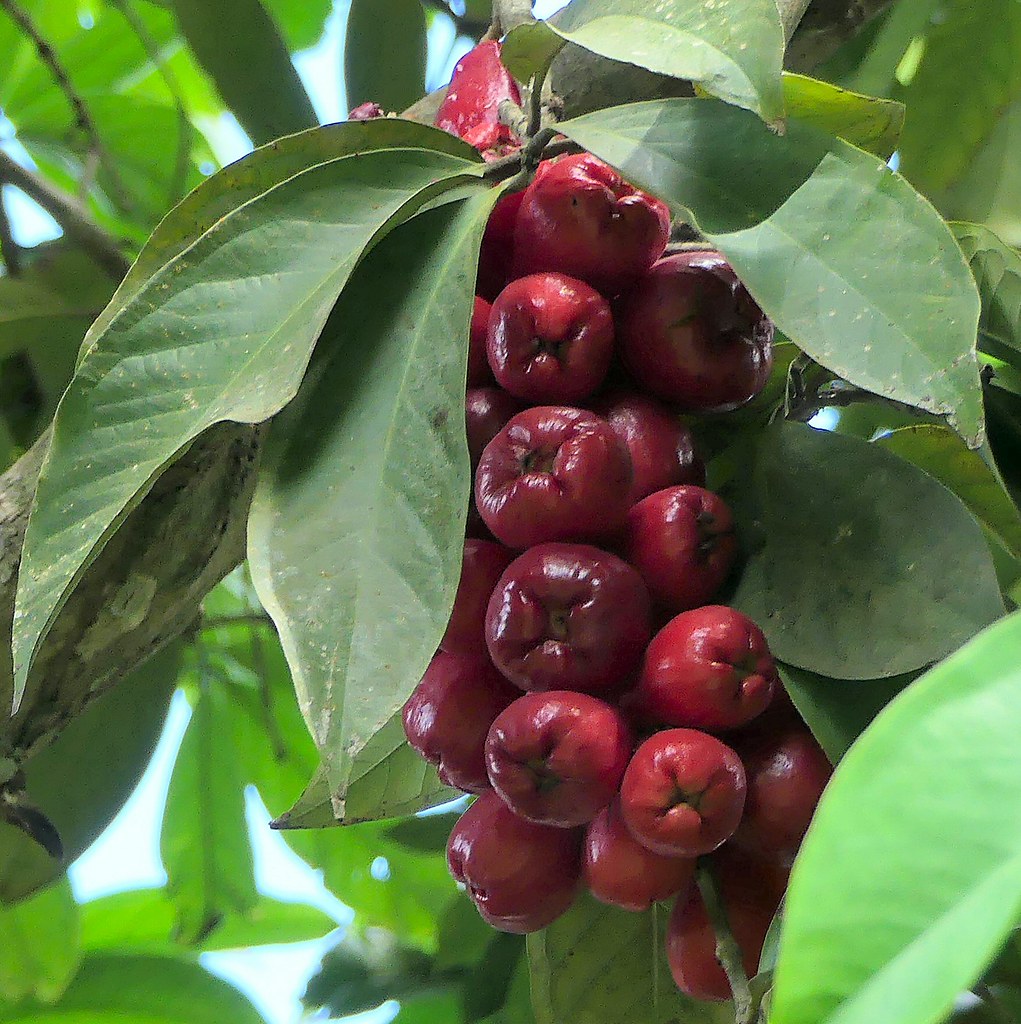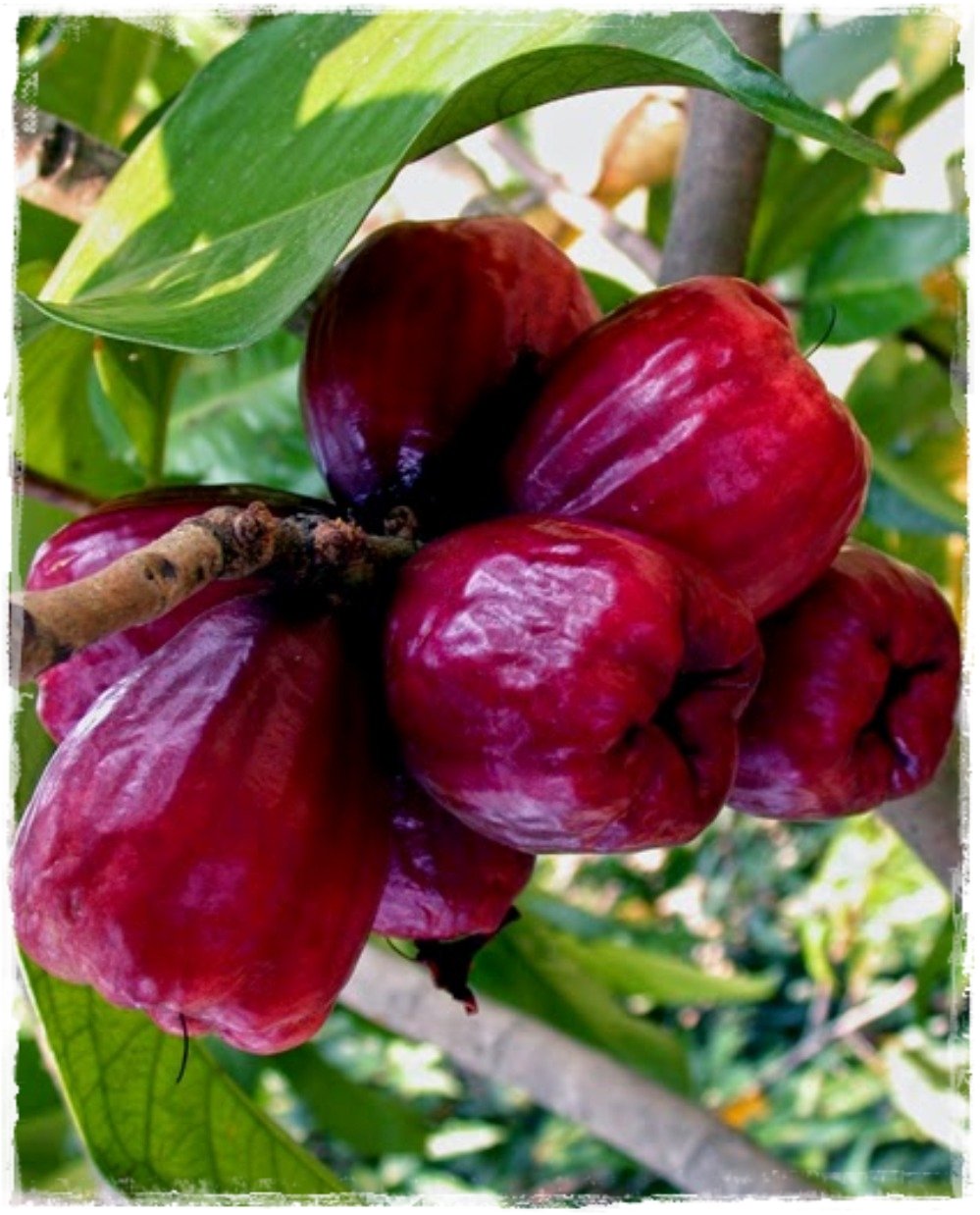A delight to the eye in every respect, CASHEW FRUIT is much admired for the beauty of the tree, its flowers and its colorful, glistening fruits, without parallel belonged in the family Myrtaceae.
Cashew (Syzygium malaccense) is a very beautiful fruit, usually deep red in color, pear shaped, with a waxy skin, about the size of an apple. Flesh is crunchy, often juicy, with a mild sweet flavor. Some varieties have white or pink skin. Cashew is native to Malaysia and is known by many names throughout the world. Some of these are: Malay apple, Rose apple, Pomerac and Cashew in Guyana.
Origin Of Cashew
Cashew originates in the Indo-Malayan region throughout Southeast Asia’s lowlands and forests. Though not native to this area, it has ancient roots in Polynesia as well: In Hawaii, religious icons were carved from the wood, which the Polynesians and Fijians held as sacred. These groups also made gorgeous leis from blossoms and fruit. Indeed, cashew trees create a rich mauve carpet when shedding their pompom-like flowers.
Today, the fruit grows throughout Southeast Asia, Indonesia, Jamaica, Guyana, Puerto Rico, El Salvador, Surinam, and Panama. Hawaii is the only state in the US that can foster the growth of cashew, as neither California nor Florida is tropical enough. The fruit is also new to South Africa.
Description Of Cashew

Cashew | https://www.flickr.com/photos/timrandall44/
The Cashew tree is rather fast-growing, reaching 40 to 60 ft in height, and has an erect trunk to 15 ft in circumference and a pyramidal or cylindrical crown. Its evergreen leaves are soft-leathery, dark-green and fairly glossy on the upper surface, paler beneath; 6 to 18 inches long, 3 1/2 to 8 inches wide. Though showy, the flowers are hidden by the foliage until they fall and form a lovely carpet on the ground. The fruits are bell shaped and can be up to eight inches long. The taste can be described as a rose water flavored apple, and they have a thin smooth waxy skin, rose red or crimson colored. The tantalizing interior flesh is white, crisp, juicy and sweet with a floral hint.
Nutritional Value Of Cashew
The Cashew fruit contains energy of 56 kilocalories, 0.6 grams of protein, 14.2 grams of carbohydrates, 0.3 grams of fat, 29 milligrams of calcium, 16 milligrams of phosphorus, and 1 milligram of iron. Also the cashew fruit also contain vitamin A as much as 130 IU, vitamin B1 0.02 milligrams and vitamin C 22 milligrams.
Health Benefits Of Cashew
- Control Diabetes – Jambosine is a type of alkaloid, found in cashew that has shown promising results in blocking or regulating the conversion of starch into sugar. This could be a very important development for diabetics and those at risk of developing diabetes. Further research is ongoing about the impact of jambosine on blood sugar control.
- Aid in Digestion – The high fiber content of cashew makes them very good for regulating the passage of food through your digestive tract, relieving constipation, and more serious health conditions. Also, in traditional medicine, the seeds of cashew have been used to prevent diarrhoea and dysentery.
- Reduce Toxicity – For hundreds of years, cashew decoctions have been used as a diuretic substance, which helps clear out liver and kidney toxicity, while also boosting the overall health and metabolic efficiency of the body.
- Anti-cancer Potential – Early traditional texts have claimed that cashews have anti-cancer potential because of their high vitamins A and C content. However, there has been no study to support these claims.
- Cholesterol and Heart Health – The fiber and nutrient combination in cashew have shown significant effects on cholesterol levels, leading to a lower risk of atherosclerosis, thereby preventing cardiovascular complications like heart attacks, strokes, and coronary heart diseases.
- Boost Immunity – The active and volatile components in cashew have been linked to having antimicrobial and anti-fungal effects. Research has shown that it can protect the skin from developing various infections and can boost the strength of the immune system against infectious diseases.
Other Benefits
- Although research is still being conducted, cashew can potentially benefit other health concerns like epileptic seizures, smallpox, inflammation in the joints, sore or strained eyes, and help in increasing the cognitive ability.
Word of Caution – The stems, seeds, and leaves of certain cultivars can be highly toxic and contain trace amounts of cyanide. Consume cashew from trusted markets and avoid excessive consumption of other parts of the fruit besides the flesh and the skin.
Culinary Uses Of Cashew
- Cashew could be consumed raw or preserved in the form of jellies and jams. It is also added in the desserts. It is also used to make the fruit sauce or syrup.
Traditional Uses Of Cashew
- Bark – The decoction made from astringent bark is used in folkloric medicine of Malaysia to treat thrush.
- Fruit – It is served as salad at the childbirth ceremony. In India, the fruit is also used as a tonic to enhance the liver and brain.
- Flower – The fever could be lessened from the sweetened prepared from the flowers.
- Leaf – The decoction made from the leaves acts as an expectorant and diuretic which treats rheumatism and also cures the sore eyes.
- Seeds – The health conditions such as dysentery, catarrh and diarrhoea could be treated with the use of seeds. The people of Nicaragua use the infusion of roasted and powdered seeds to treat diabetes. The Colombia people believe that the seeds possess the pain killer properties.
- Root – The root is used by the people of Cuban to treat epilepsy.
Medicinal Uses Of Cashew
- Root bark and fruit are used in Chinese system of traditional medicine as a blood coolant.
- Fruit peel strengthens spleen, warm stomach and treat deep ulcers and tumours.
- Fruit is used as a tonic for brain and liver.
- Flowers have antipyretic effects and seeds treat dysentery, diarrhea and catarrh.
- Bark is used to treat asthma, hoarseness and bronchitis.
Random Facts:
- Natives in Fiji and Hawaii used to offer the tree’s flowers to the volcano goddess, Pele.
- A New Guinea folk tale describes a wild girl born from a Malay apple fruit. When she stole food from a neighbouring house, she met a boy and fell in love. Cashew trees grow by the Uripa River as a tribute to her even today.
- Some farmers grow the trees to entice birds to feast on cashews instead of their coffee crops.
Cashew
Native to Malaysia, the Cashew fruit is admired for the beauty of the tree and its glistening fruits. Known locally as Cashew in Guyana, this unique fruit is enjoyed by many here in Guyana and around the world. The fruit can be consumed raw or made into jelly or jams.
Article References:
- http://theindianvegan.blogspot.com/2012/11/all-about-malay-apple.html
- https://www.fruitsinfo.com/malay-apple.php
- https://www.hort.purdue.edu/newcrop/morton/malay_apple.html
- https://www.healthbenefitstimes.com/rose-apple/
- https://en.wikipedia.org/wiki/Syzygium_malaccense







